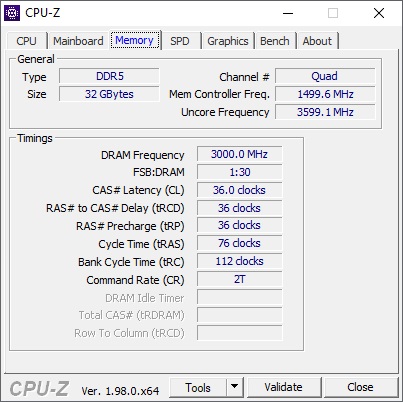Intel Alder Lake DDR5 Memory Scaling Analysis With G.Skill Trident Z5
by Gavin Bonshor on December 23, 2021 9:00 AM ESTG.Skill Trident Z5 Memory (F5-6000U3636E16G)
2x16GB of DDR5-6000 CL36
For the purposes of this article and to investigate scaling performance on Alder Lake, G.Skill supplied us with a kit of its latest Trident Z5 DDR5-6000 CL36 memory. The G.Skill Trident Z series has been its flagship model for many years, focusing on performance but blending in a premium and clean-cut aesthetic. G.Skill offers two types of its Trident Z5 memory, some without RGB LEDs such as the kit we are taking a look at today (Z5), and the Trident Z5 RGB, which includes an RGB LED light bar along the top of each memory stick.
Focusing on the non-RGB variants, the G.Skill Trident Z D5 is available in various 32 GB (2x16) configurations starting at DDR5-5600 CL36 and ranging up to DDR5-6000 CL36. G.Skill unveiled a kit of Trident Z D5 RGB DDR5-7000 CL40 kit, which is extremely fast, and when it is released, it will ultimately be one of the most, if not the most, expensive DDR5 memory kit on the market.
Looking at the design, the G.Skill Trident Z5 DDR5 memory uses a 42 mm tall (at the highest point) heatsink, with G.Skill offering a two-tone contrasting matte black kit, as well as a black and metallic silver kit. The kit supplied to us by G.Skill uses two-tone matte black heatsinks. The heatsinks are constructed from aluminum, and G.Skill states that it uses a newer and more 'streamlined' design. There are quite pointy, which given previous G.Skill memory kits might have the tendency to feel too sharp when installing them.
Looking at what CPU-Z is reporting, we can see that the X.M.P 3.0 profile matches up with the advertised specifications, with this particular kit using DDR5-6000 with latency timings of 36-36-36-76. The operating voltage for the kit is 1.3 V, which is a 0.2 V bump from the JEDEC SPD rating of this kit, which is DDR5-4800 at 1.1 V.
Checking the more intricate details of the G.Skill Trident Z5 DDR5-6000 memory, CPU-Z reports that the kit is using Samsung IC's, with a 1Rx8 array of 16 Gb ICs employed on each module. While CPU-Z doesn't actually report this, we reached out to G.Skill who informed us that this kit uses a single rank design.













82 Comments
View All Comments
milli - Thursday, December 23, 2021 - link
Are you going to start doing things the way idiots like it? Even when it's clearly wrong?Just because they don't understand it, doesn't mean you have to adhere to their wishes.
Anybody can go to Linus if they want just a show.
Oxford Guy - Friday, December 24, 2021 - link
I’m with Dr. Cutress on this. Anything below 1080 is silly to bother testing in 2021.TheinsanegamerN - Tuesday, December 28, 2021 - link
Unless you're testing memory scaling or CPU scaling, which is what is being tested here.720p/768p has a much larger pool of users then 4k does, so if were going by popularity then why ever bother testing at 4k?
Oxford Guy - Tuesday, December 28, 2021 - link
Mobile casual gaming has a larger pool of users than 1080 on PCs. That doesn't mean tests that are relevant for mobile devices are worth doing on PCs with decent discrete GPUs.4K testing has always been relevant as a demonstration of the wall one hits due to diminishing returns.
TheinsanegamerN - Monday, January 3, 2022 - link
And 720p testing is also relevant as a demonstration of theoretical CPU scaling in games, yet people seem to have a hard on for demanding it's removal from CPU scaling reviews, for some reason.YukaKun - Thursday, December 23, 2021 - link
What if you disable the E-cores and check the ring-BUS speeds relative to the RAM and the benchmark numbers?I have a feeling this may be a similar pain as Zen and the IF.
Regards.
thestryker - Thursday, December 23, 2021 - link
This would be very interesting to check out, and if not on the whole suite maybe just something like WinRAR where we're seeing a lot of scaling already.haukionkannel - Friday, December 24, 2021 - link
HU did test that and disabling E-cores did not help. 1% difference...YukaKun - Friday, December 24, 2021 - link
They didn't do RAM scaling though. And only focused on games.Regards.
mikk - Thursday, December 23, 2021 - link
What the hell, 4k and 1440p with a GTX 1080! This is all heavily GPU bound, this RAM scaling is so useless. What a bad test, I'm spechless.